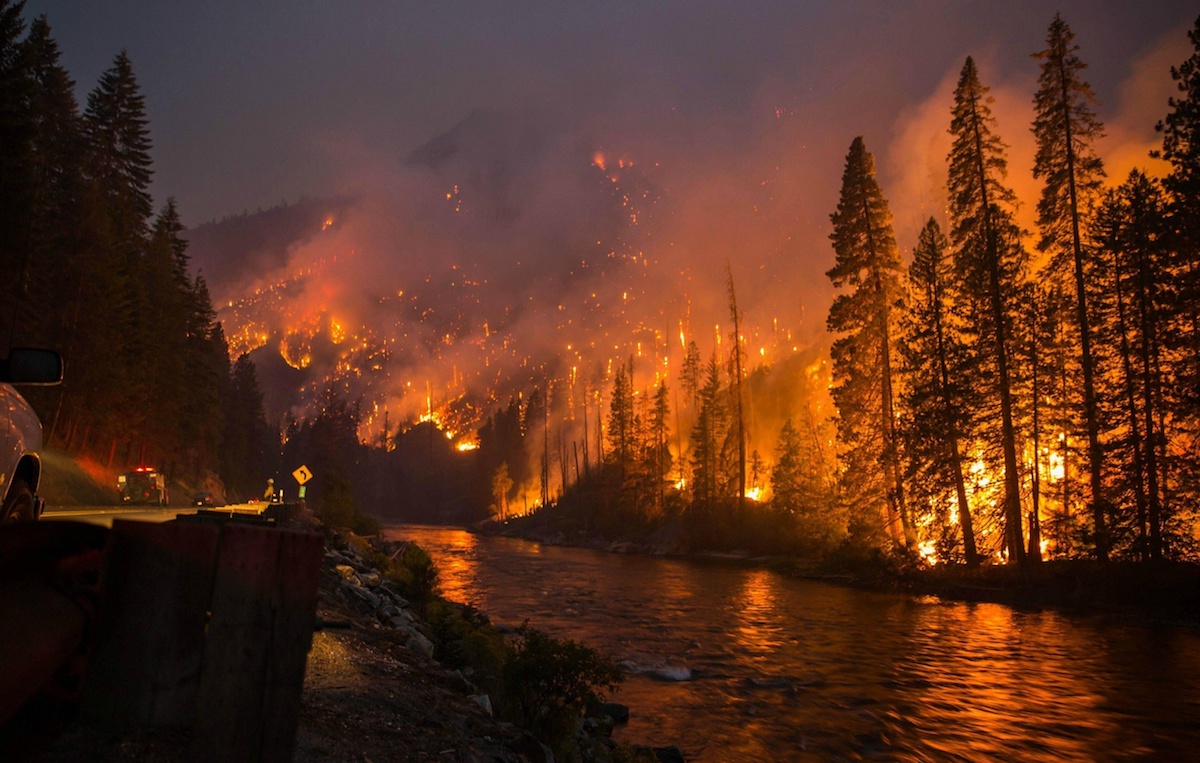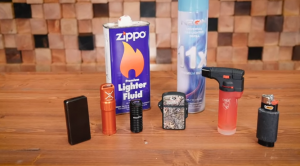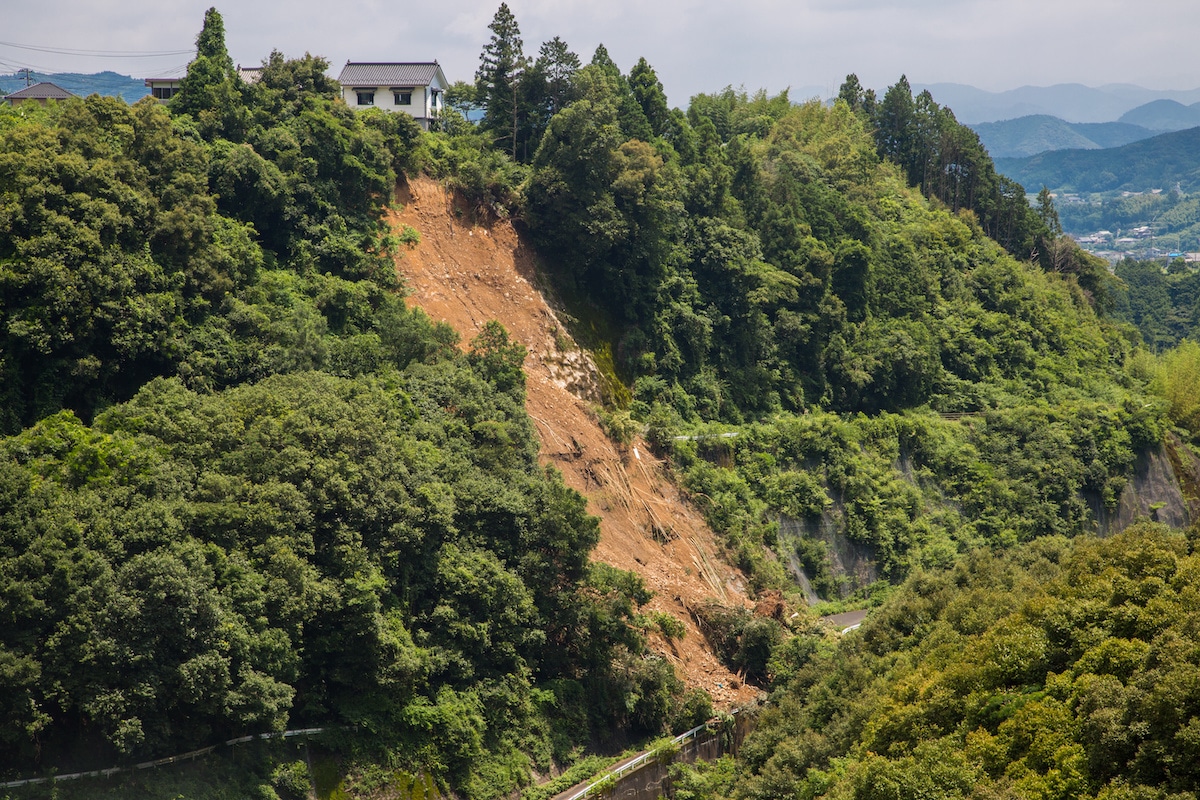There’s never a better time to enjoy the great outdoors than when the weather is nice and you have the time to get out of your house to camp, hike, or just spend a day outside. But when you are exposing yourself to the elements of nature, it is important to be vigilant and understand how to stay safe while maintaining a campfire, and what to do in case of an emergency.
What We'll Cover
- The Destructive Power of a Forest Fire
- Surviving a Forest Fire On Foot
- Prepare in Advance
- Get to Low Ground
- Take Cover Away From Vegetation
- Lay Facedown With Face Covered and Feet Facing Fire
- Surviving a Forest Fire in Your Car
- Prepare in Advance
- Park Car Away From Vegetation
- Close All Vents and Windows
- Lie on Vehicle Floor
- Cover Self With Wool Blanket or Jacket
- Surviving a Forest Fire in Your Home
- Prepare in Advance
- Shut Off Gas
- Fill Sinks and Tubs With Cold Water
- Move Furniture and Window Treatments Away From Windows and Doors
- Create a Fire-Resistant Zone Around Home
- Wet Down Your Space
- Keep Windows and Doors Closed, But Not Locked
- Make Your Home Easier to See
- Stay Away From Outside Walls and Windows
- Best Fireproof Terrain to Hide in for Protection
- How to Be Safe After a Forest Fire
- The Importance of Forest Fire Prevention
One such emergency that may happen—especially if you are spending time in an area with higher fire risks—is a forest fire. This guide will help you be prepared in case of this emergency.
The Destructive Power of a Forest Fire
The dangers and chances of a forest fire may be more than you would think; in 2019, over 50,000 forest fires occured, burning about 4.7 million acres. Fires can travel extremely quickly, spreading at a rate of 6 miles per hour. If there is an upward slope area, flames can travel even faster; just an extra 10-degree slope can double the speed of a fire, meaning that you must stay diligent if you happen upon a fire, no matter where you are.
Surviving a Forest Fire On Foot
If you happen to come across a fire while on foot, such as during hiking, walking, or camping far away from a vehicle, here are some things to keep in mind.
Prepare in Advance
Always be prepared. Before you go into the woods for your outdoor adventure, make sure that you bring all of the essentials in addition to the fun things like your marshmallow roasting sticks. Having adequate food, water, footwear, a first aid kit, and N95 masks are just a few of the main items you should have on hand when exploring the wilderness.
Get to Low Ground
If and when a forest fire occurs, you want to get low to the ground. Do not climb higher, and try to get as low to the ground as possible. The lower you are, the better chance you have of finding quality oxygen and getting below the smoke.
Take Cover Away From Vegetation
Try to get away from heavy vegetation, as it can get caught up in flames and burn quickly. Fires spread even more quickly in vegetation — as fast as 14 miles per hour in grasslands. Stay away from heavy vegetation, and try to get as far as possible from too many trees or bushes.
Lay Facedown With Face Covered and Feet Facing Fire
If you cannot escape the fire via foot, a last resort is to lay facedown with your face covered and feet facing the fire. If you have an aluminum fire shelter, it can help to place it over your body while you try to wait out the flames. Staying as flat to the ground as possible is crucial, with your nose and mouth pressed down to the ground to minimize your radiation profile and be able to breathe cooler, denser air. Though this is a last-effort resort, it may be life-saving as long as you stay safe and calm, and can stand up as soon as the fire passes to get fresh air.
Surviving a Forest Fire in Your Car
You may come across a forest fire while driving or even camping in your car. Although you have the advantage of a vehicle closeby, you still need to stay safe and be as watchful as you would be even when facing a forest fire on foot.
Prepare in Advance
No matter what, you should always be prepared when going into the forest. Keep the same essentials mentioned earlier (food, water, a first aid kit, N95 masks, and a wool blanket or jacket) in your car at all times. These items will be crucial if you happen to come across a wildfire.
Park Car Away From Vegetation
Try to always park your car away from any vegetation. If you are in the middle of the woods, drive away from all vegetation immediately and try to find an opening such as a big field or large road. If you can drive fully away from the fire, try to do so in a timely manner while staying safe.
Close All Vents and Windows
Make sure to roll up all windows and close all vents in your vehicle, as doing so will help ensure that you do not inhale too much smoke from the fire. Fresh, clean air is vital for your health and lungs.
Lie on Vehicle Floor
If you cannot drive far enough away from the fire in a timely matter, get lower in your car by lying on the floor away from windows. The lower you are, the better chance you have to inhale clean, cool air.
Cover Self With Wool Blanket or Jacket
Find a wool blanket or jacket in your car to cover your body. This will help with the heat and to trap in the fresh air for you to breathe. While laying as low to the ground as possible in your vehicle, make sure to cover your entire body, especially your face, with your blanket or jacket.
Surviving a Forest Fire in Your Home
Sometimes, experiencing a forest fire doesn’t mean that you are venturing out into the outdoors — you may already live in the forest! In 2019, Verisk Wildfire Risk Analysis identified 4.5 million homes as high or extreme risk of wildfire.
Prepare in Advance
Especially if you live in a home that is at higher-risk for forest fires, you should always be prepared for the possibility of a fire coming close to your surroundings. Don’t wait until it’s too late to have these essential items in your house.
Keep Necessary Equipment on Hand
Make sure that somewhere accessible in your home, you have storage with a first aid kit, N95 masks, an air filter or purifier, medicine, a fireproof safe for protective documents, emergency radio, supply of food and water, and any other essential items to keep you safe.
Sign Up For Community Warning Systems and Know Community Evacuation Strategy
By doing a quick online search, you can find where to sign up for alerts from your local community for warnings and evacuation notices. Search something like “how to sign up for fire alerts” so you can discover the website where you can input your phone number and receive alerts so you are ready and aware next time there may be a warning in your area.
Purchase Adequate Insurance for Your Home
If your home is located in a high-risk fire zone, then you must have adequate insurance coverage. Fire insurance will protect your home in the case of replacements, repairs, or reconstruction that your regular property insurance will not cover.
Shut Off Gas
If your house is located in a fire zone, turn off propane at the tank or natural gas at the meter, and turn off all pilot lights. You do not want to increase the chances of a fire spreading to your home or the gas exploding when a fire is in the vicinity of your property.
Fill Sinks and Tubs With Cold Water
Filling up your sinks, bath tubs, and any additional buckets you may have with water inside your home is essential to make sure that any embers that may come into the house will extinguish. Placing any large buckets or trash cans filled with water around the home will also help to trap any embers.
Move Furniture and Window Treatments Away From Windows and Doors
Moving furniture into the middle of each room is important to make sure that these flammable materials do not get caught in the fire, because you do not want to give the fire more to cling to and keep burning.
Create a Fire-Resistant Zone Around Home
Just as you should fill any large buckets or trash cans with water outside to extinguish embers, you also want to clean up around your home to make it more fire-resistant. Swiftly remove leaves, debris, or other flammable materials at least 30 feet from your home so that they cannot easily catch the flames.
Wet Down Your Space
Dry areas will burn easily; you want to make sure that your home and its surrounding property is not easily flammable. When wetting down the space surrounding your home, prioritize your roof, near above-ground fuel tanks and shrubs within 15 feet of your home.
Keep Windows and Doors Closed, But Not Locked
Immediately shut all windows and doors in your home so that the heat, smoke, and sparks will not get indoors. Do not lock your doors, as you do not want the locks to melt and want to keep a possible opening in case you need to escape your home.
Make Your Home Easier to See
Turn on exterior lights and the lights in all rooms to make your home more visible in heavy smoke.
Stay Away From Outside Walls and Windows
Just like the furniture moved to the middle of the room, it is important to stay away from the exterior of the house, especially the windows and doors.
Best Fireproof Terrain to Hide in for Protection
No matter where you are when a forest fire occurs, there are a few places that are safer to hide in to be best protected.
Water
If there is a body of water near a fire approaching, you will be safer getting into it rather than staying in the woods. Water extinguishes fire, and because water will not burn, it will also protect you by keeping you safe from the heat. The bigger the body of water, the better.
Stone
Stone will not burn from the temperature of a forest fire. Finding a rockslide (or even a stone cliff face) is a safe place to hide from the flames. Make sure the stone area you find does not have any vegetation or foliage, which is still prone to burning — even if hidden within the stone.
Meadow
Finding a large meadow to go to during a forest fire is better than being in the middle of a forest. Make sure to cut or rip down any tall grass or plants.
Underground
Although going underground isn’t the most ideal situation, it is still better than being in the middle of the fire. If you cannot find any of the above solutions to help you escape the forest fire, somewhere low to the ground like a cave is better to beat the heat and get to a lower ground with more oxygen available.
Road
The last place to go to, if nothing else is possible, is a road. Many roads aren’t usually wide enough to escape a fire but are still a better option than being in the forest. Try getting to the lowest point of the road as possible and furthest away from the fire as you can.
How to Be Safe After a Forest Fire
If you’ve encountered a forest fire, you still want to be safe and on alert after the fire is done burning. If you are returning to your home, make sure that the area has been deemed safe by officals. Check the ground as well as your roof and inside of the home for hot spots, and use your tubs of water to be sure there are no lingering embers. Be on alert for a few days after — especially in dangerous areas with high vegetation. Call for help if you perceive any danger or a possible outbreak of a fire again.
The Importance of Forest Fire Prevention
The best fight against a forest fire is to be proactive in preventing it from ever happening. Be sure to pay attention to fire threat levels where you are, and obey all rules regarding campfires, fire starters and camping matches. Properly dispose of any charcoal or smoking materials, and have the proper equipment such as a firewood stand and firefighting tools with you.
The responses below are not provided, commissioned, reviewed, approved, or otherwise endorsed by any financial entity or advertiser. It is not the advertiser’s responsibility to ensure all posts and/or questions are answered.



![Best Archery Sets This 2023 [Men & Women]](/assets/images/8cf78150f1d9d7a0c175609145d21517.png)

